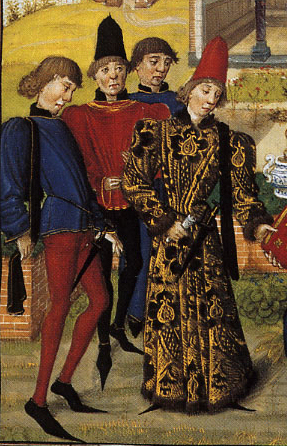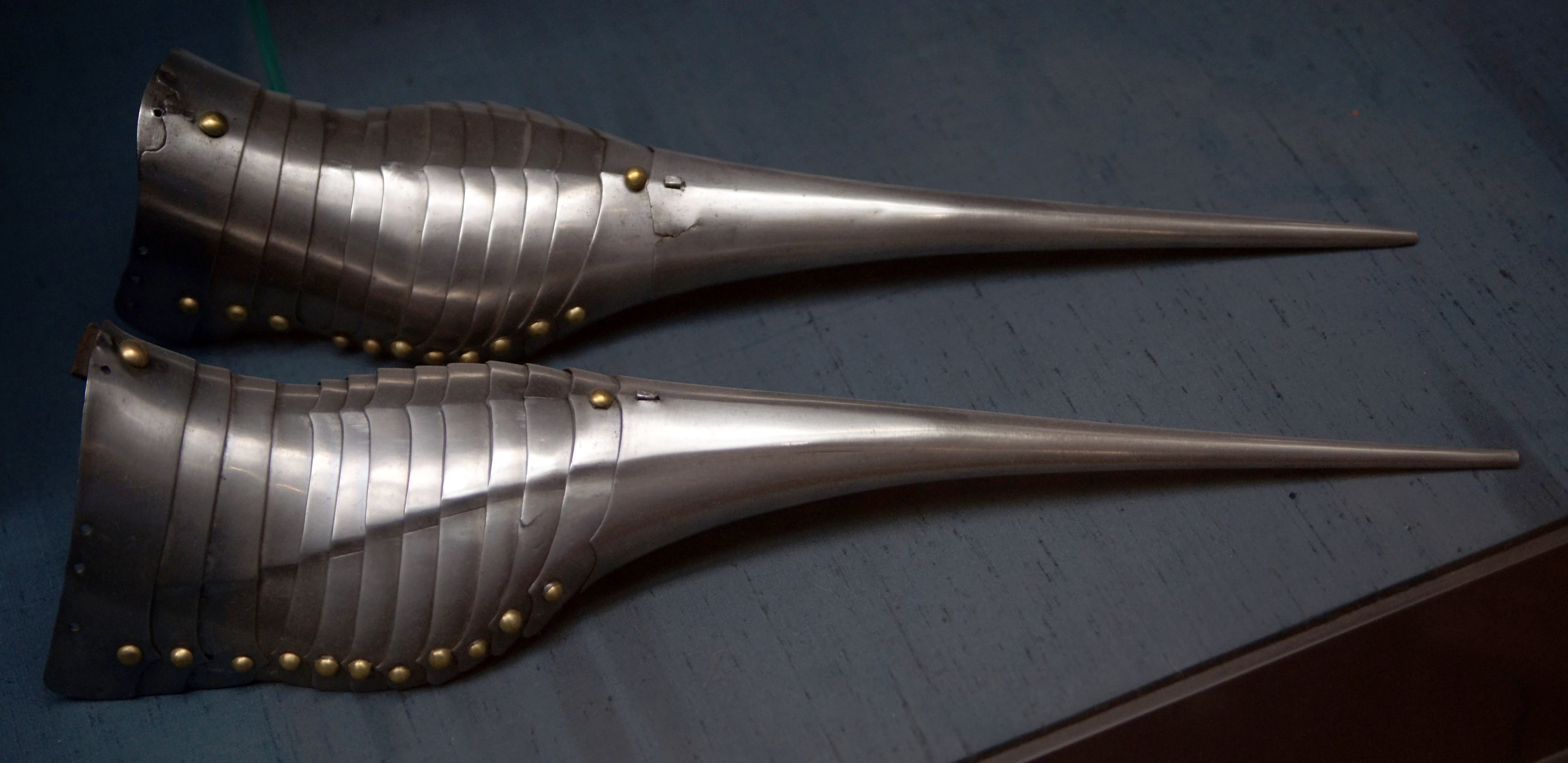Poulaine on:
[Wikipedia]
[Google]
[Amazon]
 Crakows or crackowes were a style of shoes with extremely long toes very popular in 15th century Europe. They were so named because the style was thought to have originated in
Crakows or crackowes were a style of shoes with extremely long toes very popular in 15th century Europe. They were so named because the style was thought to have originated in

 As with many items of high fashion the most extreme examples were worn by the upper classes. In periods when poulaine toes were popular most shoes were somewhat pointed, even those used during warfare. There is clear evidence from the
As with many items of high fashion the most extreme examples were worn by the upper classes. In periods when poulaine toes were popular most shoes were somewhat pointed, even those used during warfare. There is clear evidence from the  A surviving pair of
A surviving pair of
 Crakows or crackowes were a style of shoes with extremely long toes very popular in 15th century Europe. They were so named because the style was thought to have originated in
Crakows or crackowes were a style of shoes with extremely long toes very popular in 15th century Europe. They were so named because the style was thought to have originated in Kraków
Kraków (), or Cracow, is the second-largest and one of the oldest cities in Poland. Situated on the Vistula River in Lesser Poland Voivodeship, the city dates back to the seventh century. Kraków was the official capital of Poland until 1596 ...
, the then capital of Poland
Poland, officially the Republic of Poland, is a country in Central Europe. It is divided into 16 administrative provinces called voivodeships, covering an area of . Poland has a population of over 38 million and is the fifth-most populous ...
. They are also known as poulaines or pikes, though the term ''poulaine'', as in ''souliers à la poulaine'', "shoes in the Polish fashion", referred to the long pointed beak of the shoe, not the shoe itself.
History
Long-toed shoes had been popular in Europe at different times, first appearing in the archaeological record in the 12th century and falling in and out of fashion periodically. They reached their most exaggerated form in the third quarter of the 15th century before falling out of fashion in the 1480s. The arrival of this fashion in England is traditionally associated with the marriage of Richard II and Anne of Bohemia in 1382. An anonymous 'monk of Evesham' recorded in 1394: "With this queen there came from Bohemia into England those accursed vices (English ''Cracowys'' or ''Pykys'') half a yard in length, thus it was necessary for them to be tied to the shin with chains of silver before they could walk with them." However, there are indications they were worn as early as the 1360s. The author of the ''Eulogium Historiarum'' describes men of this period as wearing "points on their shoes as long as your finger that are called crakowes; more suitable as claws... for demons than as ornaments for men." Fourteenth-century poulaine-toed shoes found in London were found only in men's sizes, but 15th century art shows them being worn by both men and women, with the toes of men's shoes being the most extravagantly long. They were a controversial fashion and faced criticism from several quarters. In 1368,Charles V of France
Charles V (21 January 1338 – 16 September 1380), called the Wise (french: le Sage; la, Sapiens), was King of France from 1364 to his death in 1380. His reign marked an early high point for France during the Hundred Years' War, with his armi ...
issued an edict banning their construction and use in Paris. An English poem from 1388 complained that men were unable to kneel in prayer because their toes were too long.
In 1463, Edward IV passed a sumptuary law
Sumptuary laws (from Latin ''sūmptuāriae lēgēs'') are laws that try to regulate consumption. '' Black's Law Dictionary'' defines them as "Laws made for the purpose of restraining luxury or extravagance, particularly against inordinate expendi ...
restricting anyone "under the state of a Lord, Esquire, rGentleman" from wearing poulaines over the length of two inches. In 1465, they were banned in England altogether, so that all cordwainer
A cordwainer () is a shoemaker who makes new shoes from new leather. The cordwainer's trade can be contrasted with the cobbler's trade, according to a tradition in Britain that restricted cobblers to repairing shoes. This usage distinction is ...
s and cobbler
Cobbler(s) may refer to:
*A person who Shoemaking, repairs, and sometimes makes, shoes
Places
* The Cobbler, a mountain located near the head of Loch Long in Scotland
* Mount Cobbler, Australia
Art, entertainment and media
* The Cobbler (1923 ...
s within the City of London
The City of London is a city, ceremonial county and local government district that contains the historic centre and constitutes, alongside Canary Wharf, the primary central business district (CBD) of London. It constituted most of London fr ...
were prohibited from making shoes with pikes more than two inches long.
The poulaine inspired later footwear fashions, such as the 1950s Winklepicker boots.
Features
Stuffing
Poulaine toes were packed with stuffing to provide rigidity and help them hold their shape. Surviving examples from medieval London have the points stuffed withmoss
Mosses are small, non-vascular flowerless plants in the taxonomic division Bryophyta (, ) '' sensu stricto''. Bryophyta (''sensu lato'', Schimp. 1879) may also refer to the parent group bryophytes, which comprise liverworts, mosses, and hor ...
. An Italian chronicler noted in 1388 that they were also sometimes stuffed with horsehair.
Tying up the toes
Although there is no archaeological or medieval iconographic evidence to support the idea that the toes were ever tied up to the leg, as noted earlier, there is direct literary evidence dating from 1394 which states that this was the practice at the time these shoes were introduced into England. Additionally, the practice is mentioned by the antiquarianJohn Stow
John Stow (''also'' Stowe; 1524/25 – 5 April 1605) was an English historian and antiquarian. He wrote a series of chronicles of English history, published from 1565 onwards under such titles as ''The Summarie of Englyshe Chronicles'', ''The C ...
in his 1698 publication ''A Survey of London'', where he wrote:
However, given that John Stow was writing over 100 years after the shoes fell out of fashion, and the lack of rigorous historical research in the writings of the time, he cannot be considered a reliable source. His record of Act 4 of Edward IV is exaggerated—the actual act does mention restrictions in length, but not monetary penalties, parliament or clergy:
Poulaines as overshoes
Overshoes made from leather or cork, calledpattens
Pattens are protective overshoes that were worn in Europe from the Middle Ages until the early 20th century. Pattens were worn outdoors over a normal shoe, had a wooden or later wood and metal sole, and were held in place by leather or cloth ba ...
, were frequently worn with late medieval shoes both indoors and outdoors. The shape of pattens reflected the style of shoes in different periods, and pattens during the period where poulaine toes were fashionable have matching long toes. These pattens would have supported the toe of the shoes if required.
Toe length
Archaeological evidence in the form of surviving shoe soles shows that the length of the point beyond the toes of the foot was rarely, if ever, more than 50% of the length of the foot.This is consistent with depictions of highly fashionable European men from the third quarter of the 15th century when poulaine toes were at the height of their popularity. As with many items of high fashion the most extreme examples were worn by the upper classes. In periods when poulaine toes were popular most shoes were somewhat pointed, even those used during warfare. There is clear evidence from the
As with many items of high fashion the most extreme examples were worn by the upper classes. In periods when poulaine toes were popular most shoes were somewhat pointed, even those used during warfare. There is clear evidence from the Battle of Sempach
The Battle of Sempach was fought on 9 July 1386, between Leopold III, Duke of Austria and the Old Swiss Confederacy. The battle was a decisive Swiss victory in which Duke Leopold and numerous Austrian nobles died. The victory helped turn the lo ...
that in certain periods soldiers on campaign wore shoes with toes so long as to interfere with the wearer's ability to run. In that battle, it became necessary for the knights of Leopold III, Duke of Austria
Leopold III (1 November 1351 – 9 July 1386), known as the Just, a member of the House of Habsburg, was Duke of Austria from 1365. As head and progenitor of the Leopoldian line, he ruled over the Inner Austrian duchies of Carinthia, Styr ...
, to dismount and fight on foot, and because they did not have time to prepare for the engagement, they were forced to cut off the tips of their poulaines. The Swiss chroniclers report how a huge pile of these shoe-tips was found in a heap after the battle, and they are also depicted in the background of the battle scene in the ''Luzerner Schilling
The ''Luzerner Schilling'' (or ''Luzernerchronik'', Lucerne chronicle) is an illuminated manuscript of 1513, containing the chronicle of the history of the Swiss Confederation written by Diebold Schilling the Younger of Lucerne.
The chronicle ...
'' of 1513.
 A surviving pair of
A surviving pair of sabaton
A sabaton or solleret is part of a knight's body armor that covers the foot.
History
Fourteenth and fifteenth century sabatons typically end in a tapered point well past the actual toes of the wearer's foot, following fashionable shoe shapes ...
s belonging to Maximilian I, Holy Roman Emperor
Maximilian I (22 March 1459 – 12 January 1519) was King of the Romans from 1486 and Holy Roman Emperor from 1508 until his death. He was never crowned by the pope, as the journey to Rome was blocked by the Venetians. He proclaimed himself El ...
, have extremely long poulaines, but they were used only on horseback, and in this case the long points were detachable from the sabatons for foot combat. The catches can be seen over the area of the big toe.
See also
* Pointed shoe *Venetian-style shoe
Venetian-style shoes or Venetian-style loafers are mid-heel slippers with an upper or top part that is slightly open to the kick of the foot and the ankle bone. The venetian-style shoe and its lack of ornamentation contrasts with the loafer whi ...
*Pigache
Pigache, Poulaine and Pigage are types of shoe with a long pointed turned up toe that was worn during the Romanesque and Byzantine period. The plural form of the word is pigaciae.
The shoes were sometimes stuffed with moss, wool, or horsehair to m ...
* Winklepicker
*Duckbill shoe
A duckbill, bearpaw or cow's mouth was a style of shoe with a broad toe which was fashionable in the 15th and 16th centuries. This style started with Charles VIII of France, who had an extra toe, and was later worn by Henry VIII of England. ...
(contrasting succeeding style)
References
{{Historical clothing Shoes Historical footwear Polish clothing Medieval European costume 15th century in Europe